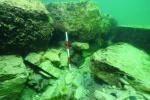Summary (English)
UNDERWATER ARCHAEOLOGICAL EXPLORATIONS OF MESAMBRIA (Nayden Prahov – naydenprahov@yahoo.com, Kalin Dimitrov) In the bay to the west of the Southern Breakwater, a sondage was carried out at the foundation of the eastern sector of the Early Byzantine fortification wall, documented in 2017 and 2018. The wall was documented along almost the entire gulf. The eastern sector of the wall is the best preserved part c. 15 m long. It was c. 2 m wide, built of stones bonded with mortar. Twelve parallel wooden posts were documented, vertically stuck into the clay layer below the foundation of the fortification wall. A cylindrical segment of a column was discovered in the central area of the bay, at 1.50 m below the sea level and close to the shore. In 2018, another segment was found there. In addition, ashlars were documented in the same area. To the east of the Southern Breakwater, the explorations of structures examined in 2017 and 2018 continued. The exploration of the rectangular fortification tower, 8 m by 8 m in size and situated at c. 3 m below the sea level, continued. The ashlars of the first row of the wall varied in size and shape. The tower was divided in two premises, 6 m by 8 m and 2 m by 8 m in size, by a wall built of smaller stones. There were two fortification walls to the west and to the east of the tower and their foundations were built of large ashlars. The tower and the walls belonged to the fortification system of the Classical period, with preserved length of c. 65 m. The fortification wall situated at c. 130 m from the coast was c. 1.20 m wide, built of large ashlars, up to 1 m by 0.50 m in size. It was preserved at c. 20 m in length. Five horizontal wooden beams incorporated among the ashlars of the first row were documented. A number of fragments from tegulae of the Corinthian Type dated to the Hellenistic period were also discovered.
- Nayden Prahov - Archaeological Institute with Museum
- Kalin Dimitrov - Centre for Underwater Archaeology
Director
- Kalin Dimitrov - Centre for Underwater Archaeology
- Nayden Prahov - Archaeological Institute with Museum
Team
Research Body
- Archaeological Institute with Museum
- Centre for Underwater Archaeology






![Download [PDF]](/excavation/skins/fasti/images/results/download_sml.png)




